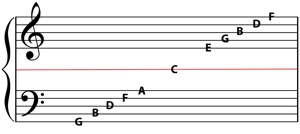I have chosen to analyse the score of the piano version of 'Slavonic Dance No. 2 In E Minor' by Dvorak. I have chosen this piece because I am learning it at the moment so I know it quite well.
Pitches
The musical alphabet consists of a, b, c, d, e, f, and g. This then repeats in a recurring sequence.
Here is an example of the fundamental principles of reading music off a staff with a treble clef:
And here is an example featuring the bass clef:
I have gone through this piece and identified the different pitches that are included.
This piece, while originally composed for an orchestra, has been adapted here for the solo piano. The range of a piano can vary slightly, but usually the average piano has around 7 octaves. This piece has an overall range of 5 octaves and 1 semitone, from a very low F# to a high G.
Intervals
The typical major/minor scale is made up of tones and semitones - these are the gaps between each note e.g. E to F is one semitone, whereas F to G is 2 semitones.
An interval is just the name for the gap between the notes, and we measure intervals by working out the number of semitones in between each note.
This shows how we describe simple intervals in western music. There are also compound intervals as well:
It can go on and on, but this covers most of the common compound intervals. The names still apply, so you can have a major ninth or a minor thirteenth etc.
As you can see, here I've gone through and worked out the different intervals that are included in this piece. I decided to call the tritone in bar 2 an augmented 4th just for consistency - interestingly enough, because the tritone is the furthest interval, it has a strange kind of dissonance about it, which Dvorak decided to make use of here. This piece features quite a few unusual intervals - augmented 4ths, minor 2nds etc. (the minor 2nd can be found in bar 5 between the E and the E# in the penultimate chord of the bar), which are used by the composer to vary the melodic line, and keep it interesting.
Chords
When more than one note is being played at a time, this is called a chord.
Chords are the building blocks of harmony, because not only do they instantly reveal what notes could be played at a particular point, but they are also used to sum up the general feeling and emotional implication of whatever notes are being played. What I mean is that if there is an E minor chord, it does not only tell you that an E, G, or B would not be out of place, but it also introduces or reinforces a negative emotion (possibly depending on the context of the chord in the piece).
Because this piece is very much in a romantic style, the chords are lush and chromatic. For example, in the second bar on the last line, the first chord is B augmented, because it contains a B, D# and a G instead of a B, D# and F# like an ordinary B chord.
Dvorak has used lots of diminished harmony in this Slavonic dance (a diminished chord is just a chord made up of intervals of minor 3rds) because it puts the listener on edge, being dissonant. The whole tonality of the 2nd bar is diminished, due to the F# diminished chord being played. As you can see, this chord is made up of F#, A, C and D#, which are all minor 3rds apart.
Cadences are sometimes referred to as 'musical punctuation'. They occur at the end of phrases in music and help determine the mood of the piece.
This piece is slightly unorthodox when it comes to cadences. In bars 7-8 Dvorak put in an interrupted cadence (which is not normal) to surprise the listener, and in bars 15-16 there is a perfect cadence. The same structure is repeated in the other half of the piece, first an interrupted cadence then a perfect cadence at the end.
Rhythms & Features
Because it would have been too messy to explain everything on the page itself, I have put numbers on the music which relate to the following explanations.
1. Semiquaver or 1/16 note
2. Crotchet or 1/4 note
3. Quaver or 1/8 note
4. Dotted quaver - held for three semiquavers
5. Dotted crotchet - held for three quavers
6. Semiquaver rest
7. Quaver rest
8.
Piano - meaning quietly
9.
Forzando - loudly and with force
10.
Crescendo - gradually getting louder
11.
Diminuendo - gradually getting quieter
12.
Staccato - played short and sharp, opposite of
legato
13.
Portato - halfway between
legato and
staccato
14.
Slur/Legato - smoothly, opposite of
staccato
15.
Pianissimo - very quiet
16.
Ritardando - gradually slowing in tempo
17. At previous tempo
18.
Mezzo Forte - moderately loud
19. Arpeggiation, rolling the notes
20. Pedal markings for the piano
As you can see, Dvorak has used a huge amount of detail in just this first page of the score. He wanted to make sure the pianist would play it with exactly the right tempo and dynamics, but with their own expressive interpretation.
Tonality
The key of this piece is E minor (F# and with a raised 7th of D#). It is in a triple metre - 3/8 - and should be played expressively and with slight rubato. Dvorak put this piece in a minor key to convey a sense of wistfulness and longing.






















